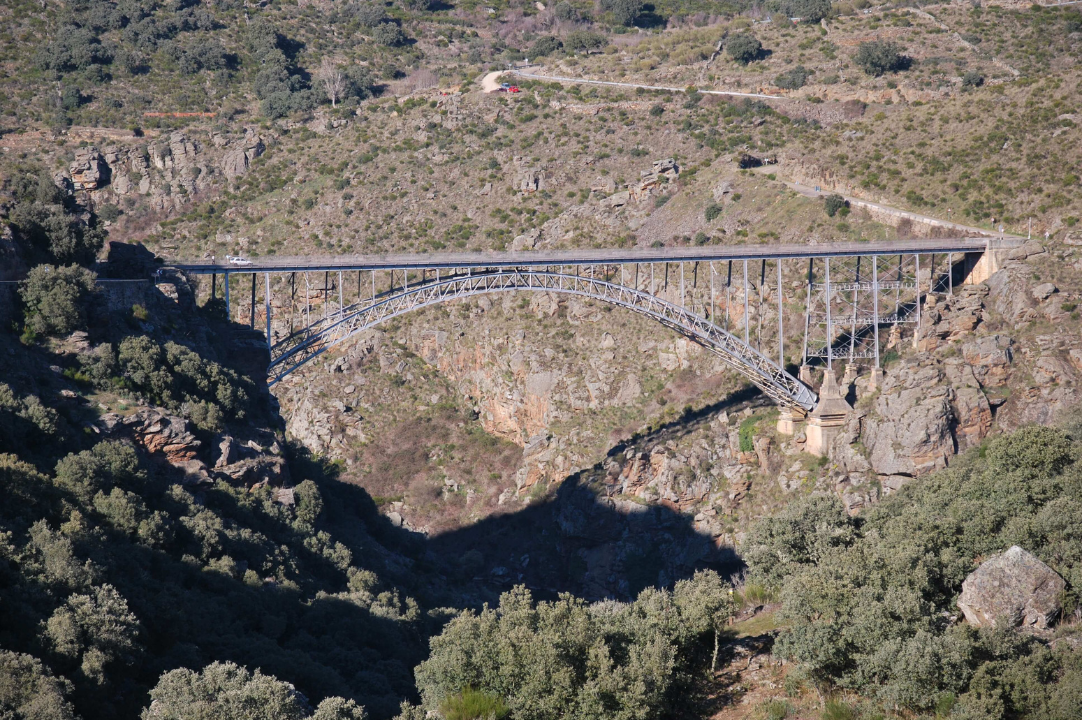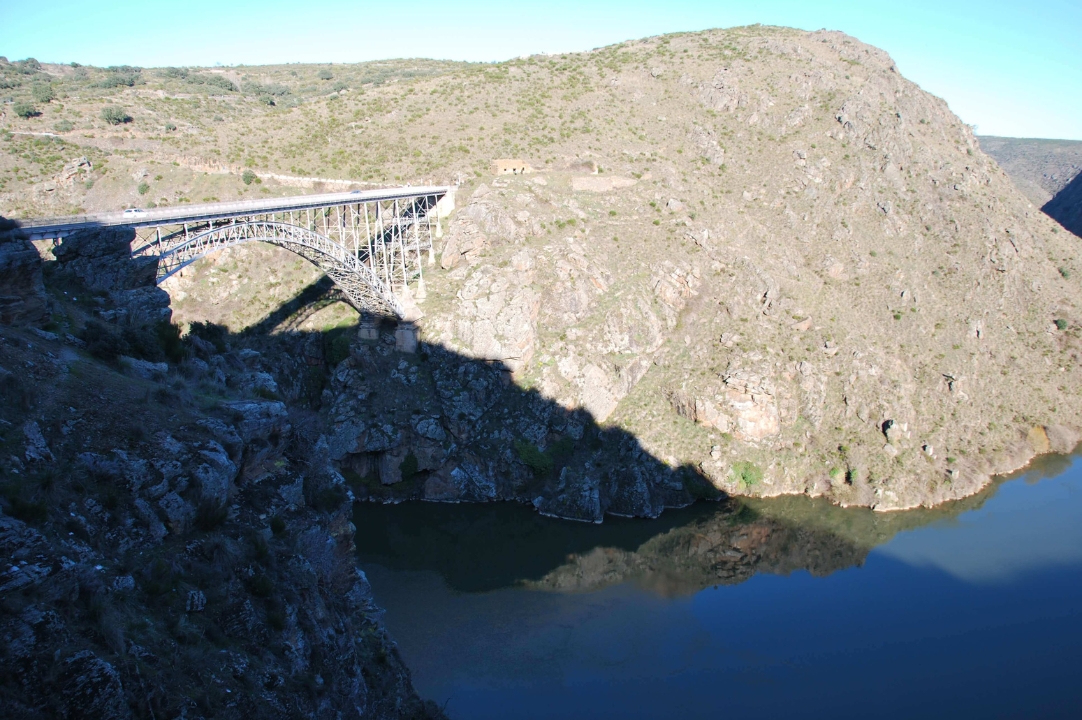Requejo Bridge or Pino Bridge
Welcome back to our blog for another month, as is now tradition. On this occasion, we are going to talk about something very important.
We are referring to the Requejo Bridge, or as we usually call it in the area, Puente Pino, one of the most popular places and one that most surprises tourists who come to spend a few days on a rural getaway at some of the rural accommodations in Los Arribes del Duero.
History and origin of the Requejo Bridge

Requejo Bridge (Arribes del Duero)
First of all, let's locate the Requejo Bridge, popularly known as Puente Pino due to its proximity to the Zamora municipality of Pino del Oro. This imposing structure, located between the municipalities of Pino del Oro and Villadepera, both belonging to the Autonomous Community of Castile and León, Zamora. It made direct communication between the regions of Sayago and Aliste possible.
Before the construction of the Requejo Bridge in 1754 by order of King Ferdinand VI, the only possible means of communication between the inhabitants of these regions of Castile and León was a small pulley boat. To travel on it, help was needed from both sides of the riverbank to pull heavy ropes that moved the unstable boat.
This explains why, as it was a task that required a lot of effort, the transport of goods was minimal. This left both areas, Pino del Oro and Villadepera, without basic resources and with shortages for long periods of time.
Features of the Requejo Bridge or Pino Bridge
To help you learn a little more about the Requejo Bridge, here are some interesting facts taken from the oldest documents.
Although construction on the Pino Bridge began in 1754, it was not officially inaugurated until September 15, 1914. Abilio Calderón, director general of public works, was in charge of its official presentation.
If the size of the Requejo Bridge is impressive today, it was even more so at that time. The Requejo viaduct is 190 meters long and approximately 90 meters above the surface of the Duero River.
In addition, if there is one element of its structure that stands out, it is its enormous steel arch, measuring over 120 meters. It should be noted that, at that time, it was one of the few bridges in Spain to feature an arch made of this material, which was the reason for the long wait before work could begin.
Finally, 450 tons of steel were used in the construction of the Pino Bridge.
What do you think of these facts?
Relationship between the Requejo Bridge and the Eiffel Tower
However, although everything we have told you is very interesting, what surprises tourists most is the connection between the Requejo Bridge or Puente Pino and the builder of the magnificent Eiffel Tower.
Before going into detail, let's take a moment to note that the construction of Puente Pino was not an easy task, nor was it a quick one.
When Mateo Sagasta was appointed deputy of the Cortes and given the position of deputy for the province of Zamora, he announced, for the first time, his proposal to build a bridge linking the towns of Pino de Oro and Villadepera. However, this project did not materialize until the arrival of Federico Requejo. A native of Zamora, born in Sayago, after much insistence, he finally managed to get the land available for the future construction of the Requejo Bridge studied. This fact also explains the origin of the bridge's name.
José Eugenio Ribera, the engineer chosen to build the imposing Requejo Bridge, had to produce many designs before, in 1754, after more than ten designs had been rejected, the structure of the bridge was finally decided. It was in that same year that José Ribera himself consulted the renowned and prestigious French engineer Gustave Eiffel.
The reason? Gustave Eiffel had proposed adding a series of large articulated arches, shaped like arrows, to the original design of the Requejo Bridge. Engineer Ribera deemed this proposal inappropriate due to its heavy weight and the high budget it would entail.
However, the main cause of the great commotion at the time was not the different points of view on the original design of the Pino Bridge. Rather, it was that Ribera (an ordinary architect) dared to reject the proposal put forward by a successful French architect such as Gustave Eiffel. At that time, Eiffel was already renowned for having built the Porto Viaduct (Portugal) and the Garabit Viaduct (France), two of the most famous bridges in Europe.
Finally, the project to build the Requejo Bridge was awarded to José Eugenio Ribera, who won his particular battle against the prestigious engineer Eiffel. Thanks to him, we can enjoy such architectural beauty with a 120-meter-long steel arch supported by concrete sections. And he managed to turn what was going to be just another insignificant bridge into one of the most important bridges in Spain, as it was one of the first bridges built in the country with a single steel arch.
Why visit the Requejo Bridge or Puente Pino?
If there is one key feature that stands out in the Los Arribes del Duero Natural Park, it is the Requejo Bridge. So much so that it ranks high on the list of “things to see in Los Arribes del Duero.” This explains why every year it is visited by hundreds of tourists who take advantage of their rural getaway to come here and stay in a rural house in the area.
But what is the main reason for its popularity? Without a doubt, and as you would expect when talking about Los Arribes del Duero, the main reason to go and see it is the impressive panoramic views that can be seen from the Requejo Bridge. Being located at such a high altitude, it offers unique views of the Tera River and all the surrounding areas, with no obstacles to block your field of vision. It's breathtaking!
Another advantage of the Pino de Zamora Bridge is that it can be viewed from different angles, such as the numerous viewpoints strategically located around Pino del Oro. They offer us panoramic views that are truly breathtaking! For example: the Peña Centigosa Viewpoint, the Puente de Requejo Viewpoint, and the Pueyos Viewpoint. If you like to enjoy views from high up, you're sure to like the recommendations we give you in our post on “the route of viewpoints” in the Arribes del Duero.

Views from the Requejo Bridge
Visit the Requejo Bridge
Today, the Requejo Bridge remains a historical landmark and a fascinating destination for curious travelers. If you want to explore its mysteries further, we invite you to stay at La Posada Doña Urraca and enjoy an exciting kayak trip through the Arribes del Duero, where expert guides will take you through the waters and you can admire the sides of the canyon, enjoy the relaxing sound of birdsong, and contemplate the imposing structure of the Puente Pino bridge from below.
We look forward to welcoming you for an unforgettable experience!

